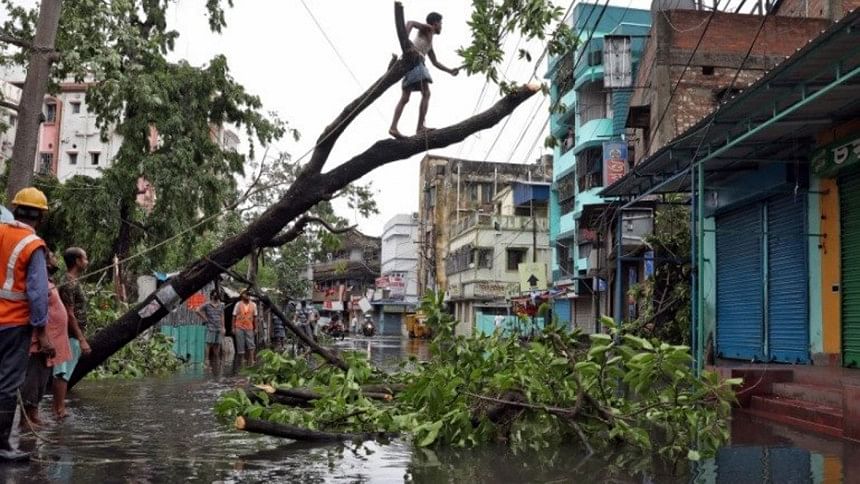Dealing with loss and damage in COP26

Loss and damage from human induced climate change is an issue that has emerged in recent years, as the adverse impacts of climate change are becoming more and more visible around the world, ranging from more severe cyclones to super wildfires and frequent floods, as well as heat waves and droughts. In Bangladesh and West Bengal last May, we suffered from the adverse impacts of Cyclone Amphan, which became a super cyclone because of the higher-than-normal sea surface temperature in the Bay of Bengal. Fortunately, the loss of human lives in Bangladesh as well as India was not as great as the many thousands who had died in previous such super cyclones because of better cyclone warning and shelter systems, but the devastation of homes, agriculture and infrastructure was great and many people have still not been able to return to their homes, months later.
The important point at issue is that loss and damage from human induced climate change is different from adaptation to climate change and also different from natural climatic and weather events. Hence, it deserves to be addressed at the United Nations Framework Convention on Climate Change (UNFCCC) negotiations.
However, the issue of how to tackle loss and damage from climate change has been a very thorny and contentious one at the UNFCCC for many years, as the developed countries refused to acknowledge it in fear of becoming open to claims of liability and compensation.
The breakthrough in the UNFCCC process came at the 19th Conference of Parties (COP19) held in Warsaw, Poland in 2014, where countries agreed to set up the Warsaw International Mechanism (WIM) on Loss and Damage. An important part of loss and damage is how to deal with displacement of people as they lose their livelihoods and are then forced to become climate migrants or climate refugees.
Dealing with loss and damage from human induced climate change in the upcoming COP26 in Glasgow, Scotland in November 2021, will be a make-or-break issue for the most vulnerable developing countries. It will therefore be incumbent on the Prime Minister of the United Kingdom, as Chair of COP26, to hold discussions with all the key countries, as well as experts and other relevant stakeholders, prior to the COP in November, if there is to be a fruitful outcome. Waiting for COP26 to start the discussion will be leaving it too late.
Another important aspect will be the role of President Biden and his Climate Envoy John Kerry, who need to be willing to discuss this thorny political issue if the US wishes to regain the credibility on tackling climate change that it lost under President Trump. The last four years, particularly the last year, has seen the planet enter into a climate-changed world where loss and damage, attributable to human induced climate change, has already become a reality.
How can we reach a landing ground where all parties might agree to tackle this thorny topic?
Let me start by giving an update on where we stand at the moment in the light of COP25, which was held in Madrid, Spain in December 2019. Going into COP25, the vulnerable developing countries joined together to put forward two key demands on tackling loss and damage, under the previously agreed WIM. The first demand was to set up a technical advisory body under the UNFCCC to provide scientific and technical advice to countries being affected by loss and damage due to human induced climate change. The second, much more contentious, demand, was for the developed countries to provide funding to the developing countries suffering from loss and damage, which went beyond adaptation as well as insurance.
At the end of COP25 in Madrid, the first demand was successfully achieved with the agreement to set up a new Santiago Network on Loss and Damage (SNLD) but the second demand for funding was not agreed upon, beyond asking the Green Climate Fund (GCF) to look into the matter. It was also referred to the Finance Committee of the UNFCCC. The significance of the name comes from the city of Santiago, which is the capital of Chile, who had the joint Presidency of COP26, together with Spain.
Based on these outcomes from COP25, there are two ways forward. The first is to develop the implementation of the SNLD, which was agreed upon but not fleshed out. This should be relatively easy as all countries have already agreed to it, but the devil is, as always, in the details. If this issue is not discussed and fleshed out then it will be reduced to being just another website! Indeed, the UNFCCC Secretariat has already set the website up and is also planning to hold a consultation on the topic. Such a result is completely inadequate from the perspective of the developing countries, whose expectations from the SNLD go well beyond this.
It is useful here to look at other examples under the UNFCCC which might be applied or even built on. The most relevant example, in my view, is the Climate Technology Centre and Network (CTCN), which was set up some years ago to provide technical assistance to developing countries to tackle climate change, and has been quite successful. It is run as a separate entity by the United Nations Environment Programme (UNEP) on behalf of the UNFCCC and has a focal point in every developing country, through which requests for technical assistance can be made which the CTCN then responds to. This model and institution have been working quite well so far.
The CTCN has been able to provide technical assistance to many developing countries, including to Bangladesh, to support both adaptation technology, such as rain water harvesting, and mitigation technology, such as solar energy. It has thus been able to establish a good working relationship with all the vulnerable developing countries.
One option for consideration for the SNLD therefore, would be to replicate the procedures for setting up the CTCN, where different organisations were invited to bid for it and UNEP was selected to set it up. This option would, however, require some time to get it up and running.
Another, faster option, might be to mandate the CTCN itself, which is already a fully functioning Secretariat, to also tackle advice on loss and damage, in addition to their existing mandate which is on technology only. This option would save time by using an existing institutional setup.
There are of course pros and cons of each option, but it should be possible to have a rational discussion or even debate and come to an agreed outcome at COP26. The key factor will be the willingness of the COP25 Presidency, namely Chile, to take up the challenge to get this issue resolved at COP26.
The second, more contentious issue of funding loss and damage is no longer on the official negotiating agenda for COP26, as it was in COP25, so it will need to be discussed and tackled at a political, rather than negotiating, level. Here, the Government of Bangladesh has an important role to play as Prime Minister Sheikh Hasina is the current chair of the Climate Vulnerable Forum (CVF), which is a high-level political forum of nearly 50 of the most vulnerable developing countries, who have recently decided to push for a political outcome on loss and damage at COP26, particularly on funding beyond adaptation and even insurance.
It is therefore incumbent on the UK as the Presidency of COP26 as well as the US under President Biden to take this issue up with Bangladesh, as well as the other vulnerable developing countries, to find a possible way forward that might not require all 196 countries to agree, but rather start with a coalition of the willing. This would involve those who are willing to support ways to deal with loss and damage, which are now clearly attributable to human induced climate change, in the poorest countries, perhaps as a solidarity fund rather than as compensation, which still remains a taboo concept for many developed countries.
One practical example for other developing countries to look at, and perhaps learn from, is the proposed National Mechanism on Loss and Damage being taken forward in Bangladesh as a public-private partnership (PPP) initiative for a two-year action research project involving government ministries and agencies, non-governmental organisations, academics and researchers, as well as the private sector, such as insurance companies. This will be piloted by Bangladesh with its own resources initially, but if successful after two years, other developed countries can also contribute to it. The aim is for Bangladesh to develop robust, transparent and reliable systems to identify loss and damage from climate change and support the victims to not just recover, but to better adapt to future climate change impacts as well. If successful, it may be a model for other developing countries to try as well.
Dr Saleemul Huq is Director of the International Centre for Climate Change and Development and Professor at the Independent University Bangladesh and Chair of the Expert Advisory Group of the CVF.

 For all latest news, follow The Daily Star's Google News channel.
For all latest news, follow The Daily Star's Google News channel. 



Comments